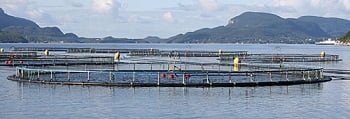New Zealand – AUT is leading a large 36-month international project to develop a technique to assess the environmental impact of offshore aquaculture.
Placing fish farms in offshore waters provides the benefits of farm waste dispersion, meaning less impact on the seafloor ecosystem. Seafloor sediment has its own microbial ecosystem breaking down organic fish waste, but there is currently no way to detect how much waste is too much waste.
AUT marine scientist Dr Kay Vopel and his team are developing a protocol for monitoring the offshore seafloor using new technology for non-invasive measurement, laboratory experiments, and mathematical modelling. This includes a seafloor lander, with an acrylic chamber that encloses a small area of the seafloor and the overlying seawater. The chamber includes various sensors, which measure changes in the chemistry of the enclosed seawater. These measurements tell researchers if and how the sediment is processing organic fish waste.
Another tripod-shaped lander is used in their project to measure how much oxygen the processing of organic waste consumes. Part of the research is also concerned with the optimisation of the lander technology. Besides various environmental sensors, the two landers are fitted with release transponders, which can send and receive acoustic signals to and from the surface.
The first trial deployments have been done in New Zealand’s Queens Charlotte Sound to a depth of 82 metres. Once collected, samples of the chamber water are analysed in the laboratory to assess how the microbial processing of fish waste affects the sedimentary nitrogen cycle. Results will be used to develop predictive modelling to support farm management and legislative and policy frameworks.
The project is part of The Blue Economy CRC, funded in part under the Australian Government’s CRC Program administered by Australia’s Department of Industry, Science, Energy and Resources and the New Zealand Seafood Innovation Ltd.
Source: AUCKLAND UNIVERSITY OF TECHNOLOGY
Stay Always Informed
Join our communities to instantly receive the most important news, reports, and analysis from the aquaculture industry.
Editor at the digital magazine AquaHoy. He holds a degree in Aquaculture Biology from the National University of Santa (UNS) and a Master’s degree in Science and Innovation Management from the Polytechnic University of Valencia, with postgraduate diplomas in Business Innovation and Innovation Management. He possesses extensive experience in the aquaculture and fisheries sector, having led the Fisheries Innovation Unit of the National Program for Innovation in Fisheries and Aquaculture (PNIPA). He has served as a senior consultant in technology watch, an innovation project formulator and advisor, and a lecturer at UNS. He is a member of the Peruvian College of Biologists and was recognized by the World Aquaculture Society (WAS) in 2016 for his contribution to aquaculture.




